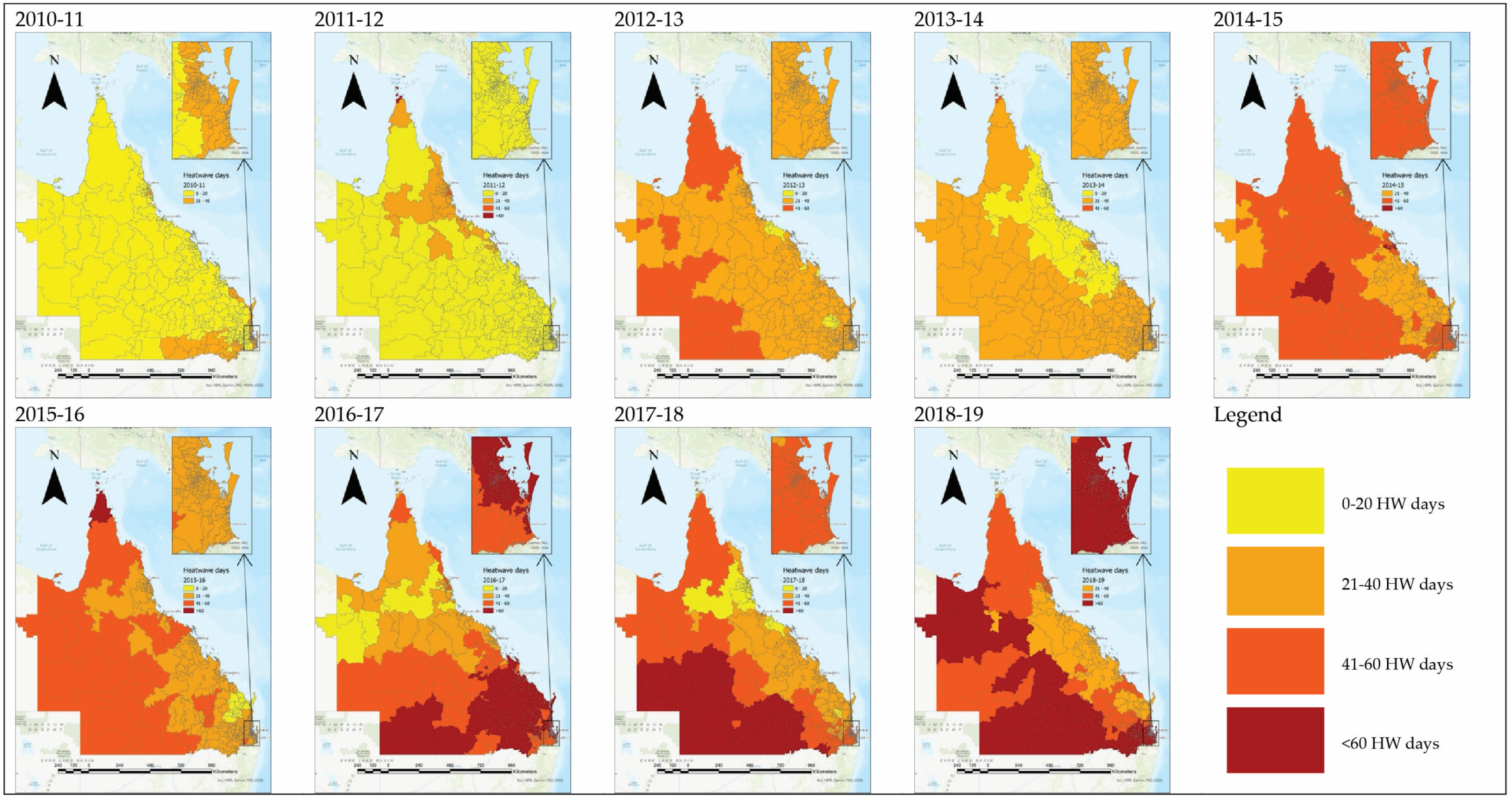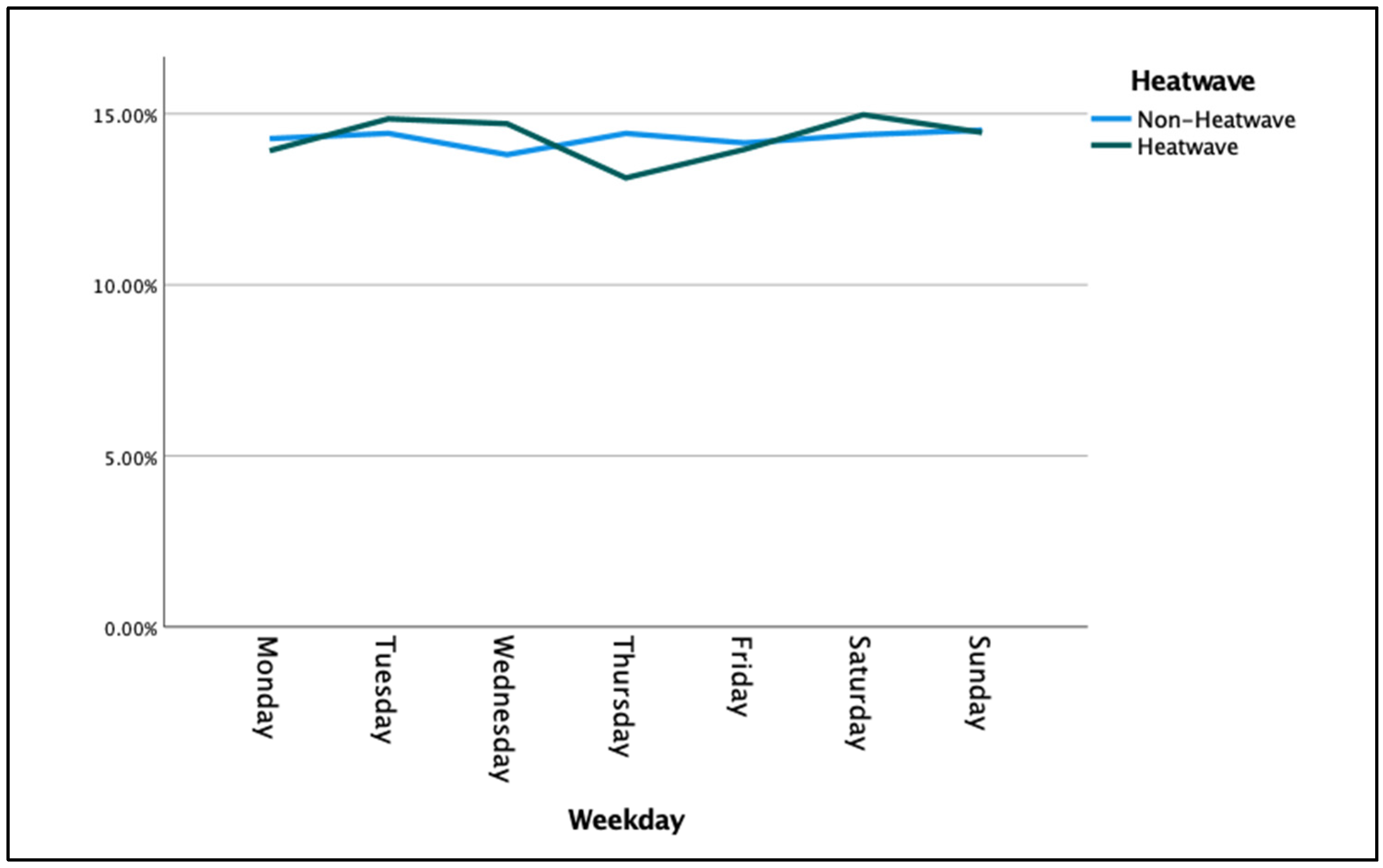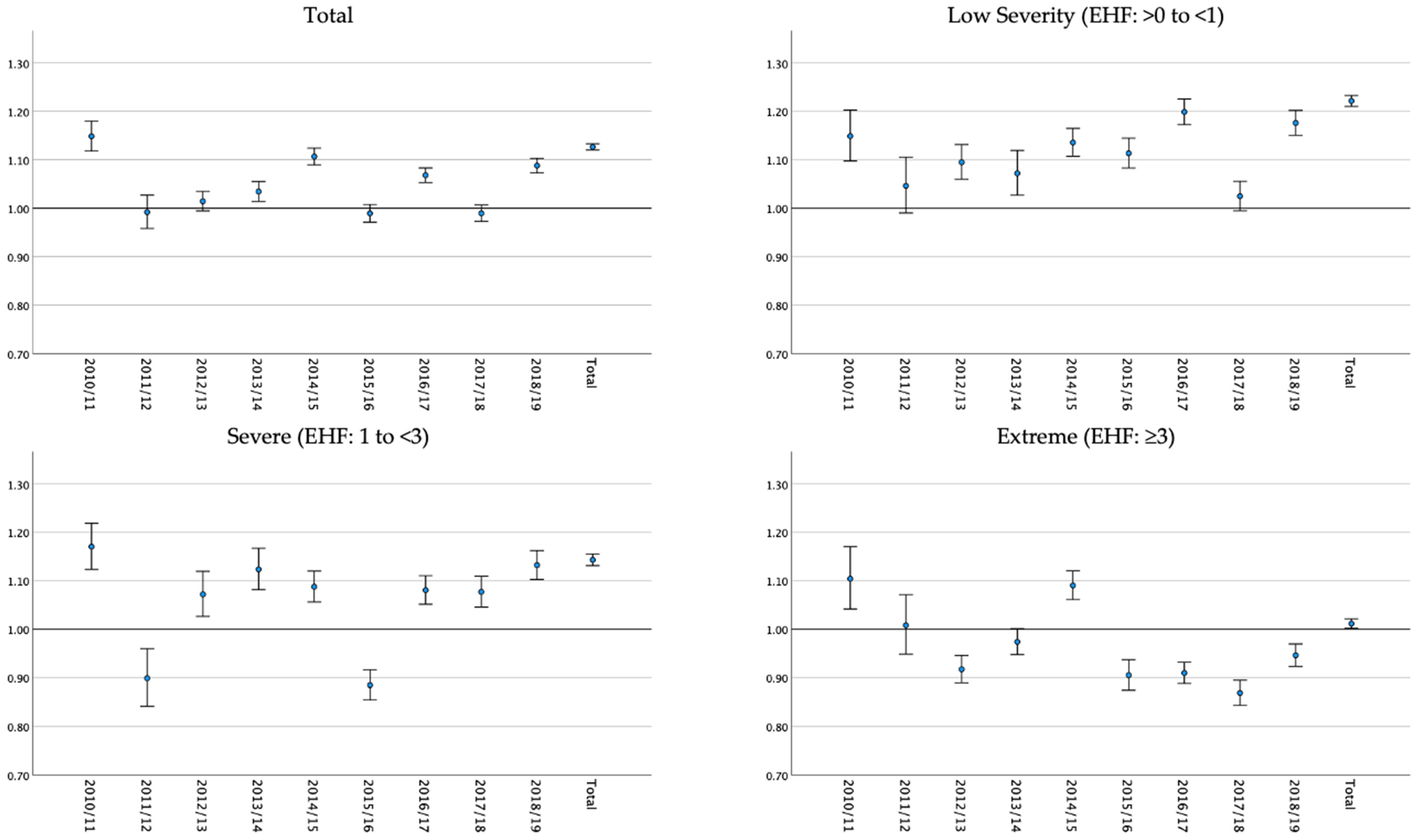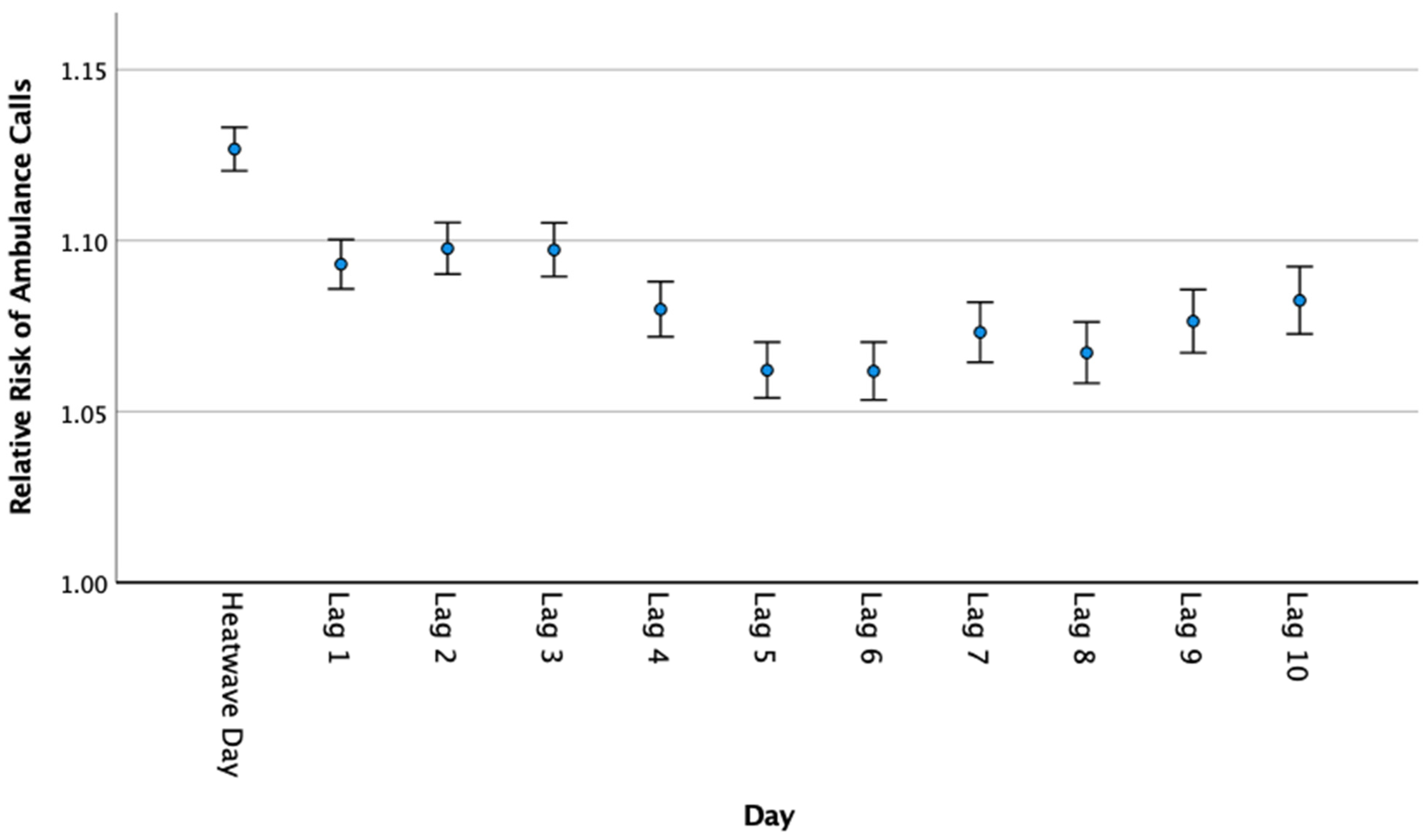Determining the Impact of Heatwaves on Emergency Ambulance Calls in Queensland: A Retrospective Population-Based Study
Abstract
1. Introduction
“…Understand health system impacts, including morbidity and mortality, related to prolonged heat exposure and unseasonal heat, through data analysis at the state-wide level…”(Strategic Objective 2) [17].
“… To ensure the ongoing sustainability of ambulance and other health care services in Queensland in a constantly changing environment…”(Strategic Objective 4).
“…We will meet the threat of a changing climate through sustainable and socially responsible planning, resourcing and operations, and models of service tailored to the health care challenges posed by climate change…”(Sub-Objective 3) [20].
2. Materials and Methods
2.1. Study Setting
2.2. Ambulance Call Data
2.3. Climate Data
2.4. Analysis
3. Results
4. Discussion
4.1. Impacts on Ambulance Services
4.2. Heatwave Severity
4.3. Rurality and Socioeconomic Status
4.4. Lag Effects
4.5. Other Factors Impacting Heatwaves and Health
4.6. Strengths and Limitations
5. Conclusions
Supplementary Materials
Author Contributions
Funding
Institutional Review Board Statement
Informed Consent Statement
Data Availability Statement
Acknowledgments
Conflicts of Interest
References
- Chesnais, M.; Green, A.; Phillips, B.; Aitken, P.; Dyson, J.; Trancoso, R.; Rajan, J.; Dunbar, K. Queensland State Heatwave Risk Assessment 2019; Queensland Fire and Emergency Service: Brisbane, QLD, Australia, 2019. [Google Scholar]
- Carey, M.G.; Monaghan, M.P.; Stanley, F.J. Extreme heat threatens the health of Australians. Med. J. Aust. 2017, 207, 232–234. [Google Scholar] [CrossRef]
- Campbell, S.; Remenyi, T.A.; White, C.J.; Johnston, F.H. Heatwave and health impact research: A global review. Health Place 2018, 53, 210–218. [Google Scholar] [CrossRef]
- Syktus, J.; Trancoso, R.; Ahrens, D.; Toombs, N.; Wong, K. Queensland Future Climate Dashboard: Downscaled CMIP5 Climate Projections for Queensland. 2020. Available online: https://www.longpaddock.qld.gov.au/qld-future-climate (accessed on 15 March 2022).
- Van Aalst, M.K. The impacts of climate change on the risk of natural disasters. Disasters 2006, 30, 5–18. [Google Scholar] [CrossRef]
- Thompson, M.; Rolfe, J.; Tonmoy, F.; Rissik, D. Queensland Climate Adaptation Strategy: Emergency Management Sector Adaptation Plan for Climate Change; Queenland Government: Brisbane, QLD, Australia, 2018; pp. 1–76. [Google Scholar]
- Scalley, B.D.; Spicer, T.; Jian, L.; Xiao, J.G.; Nairn, J.; Robertson, A.; Weeramanthri, T. Responding to heatwave intensity: Excess Heat Factor is a superior predictor of health service utilisation and a trigger for heatwave plans. Aust. N. Z. J. Public Health 2015, 39, 582–587. [Google Scholar] [CrossRef]
- Turner, L.R.; Connell, D.; Tong, S.L. The effect of heat waves on ambulance attendances in Brisbane, Australia. Prehosp. Disaster Med. 2013, 28, 482–487. [Google Scholar] [CrossRef]
- Nitschke, M.; Tucker, G.R.; Hansen, A.L.; Williams, S.; Zhang, Y.; Bi, P. Impact of two recent extreme heat episodes on morbidity and mortality in Adelaide, South Australia: A case-series analysis. Environ. Health 2011, 10, 1–9. [Google Scholar] [CrossRef]
- Hughes, L.; Hanna, E.; Fenwick, J. The Silent Killer: Climate Change and the Health Impacts of Extreme Heat; Climate Council of Australia: Sydney, Australia, 2016. [Google Scholar]
- Doan, T.N.; Wilson, D.; Rashford, S.; Bosley, E. Ambient temperatures, heatwaves and out-of-hospital cardiac arrest in Brisbane, Australia. Occup. Environ. Med. 2021, 78, 349. [Google Scholar] [CrossRef]
- Kue, R.C.; Dyer, K.S. The impact of heat waves on transport volumes in an urban emergency medical services system: A retrospective review. Prehosp. Disaster Med. 2013, 28, 610–615. [Google Scholar] [CrossRef]
- Schaffer, A.; Muscatello, D.; Broome, R.; Corbett, S.; Smith, W. Emergency department visits, ambulance calls, and mortality associated with an exceptional heat wave in Sydney, Australia, 2011: A time-series analysis. Environ. Health 2012, 11, 1–8. [Google Scholar] [CrossRef]
- Patel, D.; Jian, L.; Xiao, J.; Jansz, J.; Yun, G.; Lin, T.; Robertson, A. Joint effects of heatwaves and air quality on ambulance services for vulnerable populations in Perth, Western Australia. Environ. Pollut. 2019, 252, 532–542. [Google Scholar] [CrossRef]
- Campbell, S.L.; Remenyi, T.; Williamson, G.J.; Rollins, D.; White, C.J.; Johnston, F.H. Ambulance dispatches and heatwaves in Tasmania, Australia: A case-crossover analysis. Environ. Res. 2021, 202, 111655. [Google Scholar] [CrossRef]
- Mason, H.M.; King, J.C.; Peden, A.C.; Franklin, R.C. Systematic review of the impact of heatwaves on health service demand in Australia. BMC Health Serv. Res. 2022, 22, 960. [Google Scholar] [CrossRef]
- Queensland Health. Healthy Places, Healthy People Report; Queensland Government: Brisbane, QLD, Australia, 2021. [Google Scholar]
- Tong, S.; Ebi, K. Preventing and mitigating health risks of climate change. Environ. Res. 2019, 174, 9–13. [Google Scholar] [CrossRef]
- Queensland Government. Queensland Future Climate: Heatwaves. Available online: https://www.longpaddock.qld.gov.au/qld-future-climate/adapting/heatwaves/ (accessed on 19 December 2022).
- Queensland Ambulance Service. Queensland Ambulance Service Strategy 2022–2027. Available online: https://www.ambulance.qld.gov.au/docs/QAS-Strategy.pdf (accessed on 21 November 2022).
- Doan, T.N.; Wilson, D.; Rashford, S.; Sims, L.; Bosley, E. Epidemiology, management and survival outcomes of adult out-of-hospital traumatic cardiac arrest due to blunt, penetrating or burn injury. Emerg. Med. J. 2022, 39, 111–117. [Google Scholar] [CrossRef]
- Queensland Ambulance Service. Queensland Ambulance Service Strategy 2016–2021. Available online: https://www.ambulance.qld.gov.au/docs/qas-strategy-2016-2021.pdf (accessed on 12 June 2022).
- Queensland Ambulance Service. Survival Trends Out of Hospital Cardiac Arrest in Queensland 2000–2016. Available online: https://www.ambulance.qld.gov.au/docs/812a-qas-survival-trends-ohca.pdf (accessed on 12 June 2022).
- Franklin, R.C.; King, J.C.; Aitken, P.J.; Elcock, M.S.; Lawton, L.; Robertson, A.; Mazur, S.M.; Edwards, K.; Leggat, P.A. Aeromedical retrievals in Queensland: A five-year review. Emerg. Med. Australas 2021, 33, 34–44. [Google Scholar] [CrossRef]
- Bittner, M.-I.; Matthies, E.F.; Dalbokova, D.; Menne, B. Are European countries prepared for the next big heat-wave? Eur. J. Public Health 2014, 24, 615–619. [Google Scholar] [CrossRef]
- Wang, X.-Y.; Barnett, A.; Guo, Y.-M.; Yu, W.-W.; Shen, X.-M.; Tong, S.-L. Increased risk of emergency hospital admissions for children with renal diseases during heatwaves in Brisbane, Australia. World J. Pediatr. 2014, 10, 330–335. [Google Scholar] [CrossRef]
- Greenwood, R.; Saunders, K.; Holmes, J.; Fitzgerald, R. Queensland. Available online: https://www.britannica.com/place/Queensland-state-Australia/Plant-and-animal-life (accessed on 29 April 2022).
- Queensland Health. The Health of Queenslanders 2020: Report of the Chief Health Officer; Queensland Government: Brisbane, QLD, Australia, 2020; pp. 1–160. [Google Scholar]
- Queensland Government Statistician’s Office. Queensland Population Counter. Available online: https://www.qgso.qld.gov.au/statistics/theme/population/population-estimates/state-territories/qld-population-counter (accessed on 16 June 2022).
- Queensland Government. Interesting Facts about Queensland. Available online: https://www.qld.gov.au/about/about-queensland/statistics-facts/facts (accessed on 3 August 2022).
- Bureau of Meteorology. Australian Rainfall during El Niño and La Niña Events. Available online: http://www.bom.gov.au/climate/history/enso/ (accessed on 18 August 2022).
- International Academies of Emergency Dispatch. The Medical Priority Dispatch System. Available online: https://www.emergencydispatch.org/what-we-do/emergency-priority-dispatch-system/medical-protocol (accessed on 2 March 2023).
- Nairn, J.R.; Fawcett, R.J.B. The excess heat factor: A metric for heatwave intensity and its use in classifying heatwave severity. Int. J. Environ. Res. Public Health 2015, 12, 227–253. [Google Scholar] [CrossRef]
- Loridan, T.; Coates, L.; Argueso, D.; Perkins-Kirkpatrick, S.E.; McAneney, J. The Excess Heat Factor as a metric for heat-related fatalities: Defining heatwave risk categories. Aust. J. Emerg. Manag. 2016, 31, 31–37. [Google Scholar]
- Nairn, J.; Moise, A.; Ostendorf, B. The impact of humidity on Australia’s operational heatwave services. Clim. Serv. 2022, 27, 100315. [Google Scholar] [CrossRef]
- Lubczyńska, M.J.; Christophi, C.A.; Lelieveld, J. Heat-related cardiovascular mortality risk in Cyprus: A case-crossover study using a distributed lag non-linear model. Environ. Health 2015, 14, 39. [Google Scholar] [CrossRef] [PubMed]
- Zeng, W.; Lao, X.; Rutherford, S.; Xu, Y.; Xu, X.; Lin, H.; Liu, T.; Luo, Y.; Xiao, J.; Hu, M.; et al. The effect of heat waves on mortality and effect modifiers in four communities of Guangdong Province, China. Sci. Total Environ. 2014, 482, 214–221. [Google Scholar] [CrossRef] [PubMed]
- Guo, Y.; Gasparrini, A.; Armstrong, B.; Tawatsupa, B.; Tobias, A.; Lavigne, E.; Coelho, M.; Pan, X.; Kim, H.; Hashizume, M.; et al. Heat Wave and Mortality: A Multicountry, Multicommunity Study. Environ. Health Perspect. 2017, 10, 087006. [Google Scholar] [CrossRef] [PubMed]
- Australian Bureau of Statistics. Australian Statistical Geography Standard (ASGS): Volume 5—Remoteness Structure. Available online: https://www.ausstats.abs.gov.au/ausstats/subscriber.nsf/0/A277D01B6AF25F64CA257B03000D7EED/$File/1270055005_july%202011.pdf (accessed on 15 March 2022).
- Australian Bureau of Statistics. In 2033.0.55.001—Census of Population and Housing: Socio-Economic Indexes for Areas (SEIFA), Australia; 2016. Available online: https://www.abs.gov.au/ausstats/abs@.nsf/Lookup/by%20Subject/2033.0.55.001~2016~Main%20Features~IRSAD~20 (accessed on 15 March 2022).
- Rickards, L.; Keating, A. Implications of Climate Change for Emergency Services Operations—Insights from the Literature; Bushfire & Natural Hazards CRC: Melbourne, Australia, 2021; pp. 1–71. [Google Scholar]
- Williams, S.; Venugopal, K.; Nitschke, M.; Nairn, J.; Fawcett, R.; Beattie, C.; Wynwood, G.; Bi, P. Regional morbidity and mortality during heatwaves in South Australia. Int. J. Biometeorol. 2018, 62, 1911–1926. [Google Scholar] [CrossRef] [PubMed]
- Xiao, J.; Spicer, T.; Jian, L.; Yun, G.Y.; Shao, C.; Nairn, J.; Fawcett, R.J.B.; Robertson, A.; Weeramanthri, T.S. Variation in population vulnerability to heat wave in Western Australia. Front. Public Health 2017, 5, 64. [Google Scholar] [CrossRef] [PubMed]
- Jegasothy, E.; McGuire, R.; Nairn, J.; Fawcett, R.; Scalley, B. Extreme climatic conditions and health service utilisation across rural and metropolitan New South Wales. Int. J. Biometeorol. 2017, 61, 1359–1370. [Google Scholar] [CrossRef]
- Queensland Ambulance Service. Regions. Available online: https://www.ambulance.qld.gov.au/LASN.html (accessed on 4 January 2023).
- Toloo, G.; Guo, Y.M.; Turner, L.; Qi, X.; Aitken, P.; Tong, S.L. Socio-demographic vulnerability to heatwave impacts in Brisbane, Australia: A time series analysis. Aust. N. Z. J. Public Health 2014, 38, 430–435. [Google Scholar] [CrossRef]
- Tong, S.L.; Wang, X.Y.; Yu, W.W.; Chen, D.; Wang, X.M. The impact of heatwaves on mortality in Australia: A multicity study. BMJ Open 2014, 4, e003579. [Google Scholar] [CrossRef] [PubMed]
- Turner, L.R.; Connell, D.; Tong, S. Exposure to hot and cold temperatures and ambulance attendances in Brisbane, Australia: A time-series study. BMJ Open 2012, 2, e001074. [Google Scholar] [CrossRef]
- Queensland Department of Environment and Science. Live Air Data. Available online: https://apps.des.qld.gov.au/air-quality/ (accessed on 1 March 2023).
- Zhang, Y.; Nitschke, M.; Bi, P. Risk factors for direct heat-related hospitalization during the 2009 Adelaide heatwave: A case crossover study. Sci. Total Environ. 2013, 442, 1–5. [Google Scholar] [CrossRef]
- Xu, Z.; Tong, S.; Cheng, J.; Zhang, Y.; Wang, N.; Zhang, Y.; Hayixibayi, A.; Hu, W. Heatwaves, hospitalizations for Alzheimer’s disease, and postdischarge deaths: A population-based cohort study. Environ. Res. 2019, 178, 108714. [Google Scholar] [CrossRef]
- Borg, M.; Nitschke, M.; Williams, S.; McDonald, S.; Nairn, J.; Bi, P. Using the excess heat factor to indicate heatwave-related urinary disease: A case study in Adelaide, South Australia. Int. J. Biometeorol. 2019, 63, 435–447. [Google Scholar] [CrossRef] [PubMed]
- Zhang, Y.; Nitschke, M.; Krackowizer, A.; Dear, K.; Pisaniello, D.; Weinstein, P.; Tucker, G.; Shakib, S.; Bi, P. Risk factors of direct heat-related hospital admissions during the 2009 heatwave in Adelaide, Australia: A matched case-control study. BMJ Open 2016, 6, e010666. [Google Scholar] [CrossRef] [PubMed]
- Zhang, Y.; Nitschke, M.; Krackowizer, A.; Dear, K.; Pisaniello, D.; Weinstein, P.; Tucker, G.; Shakib, S.; Bi, P. Risk factors for deaths during the 2009 heat wave in Adelaide, Australia: A matched case-control study. Int. J. Biometeorol. 2017, 61, 35–47. [Google Scholar] [CrossRef] [PubMed]
- Williams, S.; Nitschke, M.; Tucker, G.; Bi, P. Extreme heat arrangements in South Australia: An assessment of trigger temperatures. Health Promot. J. Austr. 2011, 22, 21–27. [Google Scholar] [CrossRef]
- Yin, R. Doctor reveals severe health effects from heatwaves and humidity. news.com.au 2022.
- Pascal, M.; Wagner, V.; Alari, A.; Corso, M.; Le Tertre, A. Extreme heat and acute air pollution episodes: A need for joint public health warnings? Atmos. Environ. 2021, 249, 118249. [Google Scholar] [CrossRef]
- Rahman, M.M.; McConnell, R.; Schlaerth, H.; Ko, J.; Silva, S.; Lurmann, F.W.; Palinkas, L.; Johnston, J.; Hurlburt, M.; Yin, H.; et al. The Effects of Coexposure to Extremes of Heat and Particulate Air Pollution on Mortality in California: Implications for Climate Change. Am. J. Respir. Crit. Care Med. 2022, 206, 1117–1127. [Google Scholar] [CrossRef]
- Yu, W.; Guo, Y.; Shi, L.; Li, S. The association between long-term exposure to low-level PM2.5 and mortality in the state of Queensland, Australia: A modelling study with the difference-in-differences approach. PLoS Med. 2020, 17, e1003141. [Google Scholar] [CrossRef]






| Relative Risk (95% Confidence Interval) | |||||
|---|---|---|---|---|---|
| Low | Severe | Extreme | Total | ||
| Rurality | Major Cities (n = 1,559,021) | 1.11 (1.10, 1.13) * | 1.11 (1.09, 1.12) * | 1.12 (1.11, 1.14) * | 1.12 (1.11, 1.12) * |
| Inner Regional (n = 499,232) | 1.30 (1.27, 1.33) * | 1.10 (1.07, 1.13) * | 0.94 (0.92, 0.96) * | 1.09 (1.08, 1.11) * | |
| Outer Regional (n = 372,867) | 1.27 (1.25, 1.30) * | 1.04 (1.02, 1.07) * | 0.77 (0.76, 0.79) * | 1.04 (1.03, 1.06) * | |
| Remote (n = 786,301) | 0.95 (0.90, 1.00) | 1.18 (1.12, 1.25) * | 1.02 (0.98, 1.07) | 1.05 (1.02, 1.08) * | |
| Very Remote (n = 22,265) | 1.45 (1.38, 1.52) * | 1.27 (1.20, 1.35) * | 0.84 (0.80, 0.88) * | 1.16 (1.13, 1.20) * | |
| IRSAD | High (n = 613,194) | 1.11 (1.09, 1.13) * | 1.12 (1.10, 1.14) * | 1.09 (1.07, 1.11) * | 1.13 (1.12, 1.14) * |
| Middle (n = 1,090,899) | 1.25 (1.23, 1.27) * | 1.14 (1.12, 1.16) * | 0.98 (0.97, 1.00) * | 1.12 (1.11, 1.14) * | |
| Low (n = 786,301) | 1.27 (1.25, 1.29) * | 1.12 (1.10, 1.14) * | 0.98 (0.97, 1.00) * | 1.11 (1.10, 1.12) * | |
Disclaimer/Publisher’s Note: The statements, opinions and data contained in all publications are solely those of the individual author(s) and contributor(s) and not of MDPI and/or the editor(s). MDPI and/or the editor(s) disclaim responsibility for any injury to people or property resulting from any ideas, methods, instructions or products referred to in the content. |
© 2023 by the authors. Licensee MDPI, Basel, Switzerland. This article is an open access article distributed under the terms and conditions of the Creative Commons Attribution (CC BY) license (https://creativecommons.org/licenses/by/4.0/).
Share and Cite
Mason, H.M.; King, J.C.; Peden, A.E.; Watt, K.; Bosley, E.; Fitzgerald, G.; Nairn, J.; Miller, L.; Mandalios, N.; Franklin, R.C. Determining the Impact of Heatwaves on Emergency Ambulance Calls in Queensland: A Retrospective Population-Based Study. Int. J. Environ. Res. Public Health 2023, 20, 4875. https://doi.org/10.3390/ijerph20064875
Mason HM, King JC, Peden AE, Watt K, Bosley E, Fitzgerald G, Nairn J, Miller L, Mandalios N, Franklin RC. Determining the Impact of Heatwaves on Emergency Ambulance Calls in Queensland: A Retrospective Population-Based Study. International Journal of Environmental Research and Public Health. 2023; 20(6):4875. https://doi.org/10.3390/ijerph20064875
Chicago/Turabian StyleMason, Hannah M., Jemma C. King, Amy E. Peden, Kerrianne Watt, Emma Bosley, Gerard Fitzgerald, John Nairn, Lauren Miller, Nicole Mandalios, and Richard C. Franklin. 2023. "Determining the Impact of Heatwaves on Emergency Ambulance Calls in Queensland: A Retrospective Population-Based Study" International Journal of Environmental Research and Public Health 20, no. 6: 4875. https://doi.org/10.3390/ijerph20064875
APA StyleMason, H. M., King, J. C., Peden, A. E., Watt, K., Bosley, E., Fitzgerald, G., Nairn, J., Miller, L., Mandalios, N., & Franklin, R. C. (2023). Determining the Impact of Heatwaves on Emergency Ambulance Calls in Queensland: A Retrospective Population-Based Study. International Journal of Environmental Research and Public Health, 20(6), 4875. https://doi.org/10.3390/ijerph20064875






